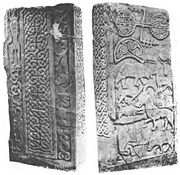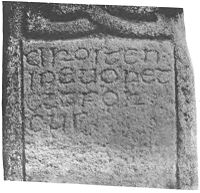
Drosten Stone
Encyclopedia

St Vigeans
St Vigeans is a small village and parish in Angus, Scotland, immediately to the north of Arbroath. Originally rural, it is now more or less a suburb of the town of Arbroath. The name St Vigeans is derived from Vigeanus, a Latinised form of the Old Irish name Féichín. Saint Feichin flourished in...
, near Arbroath
Arbroath
Arbroath or Aberbrothock is a former royal burgh and the largest town in the council area of Angus in Scotland, and has a population of 22,785...
, Scotland
Scotland
Scotland is a country that is part of the United Kingdom. Occupying the northern third of the island of Great Britain, it shares a border with England to the south and is bounded by the North Sea to the east, the Atlantic Ocean to the north and west, and the North Channel and Irish Sea to the...
. In academic contexts it is sometimes called St Vigeans 1.
The Drosten Stone is a Class 2 cross-slab: a flat rectangular stone with a cross carved on one side and symbols on the other. The stone is unusual in having a non-ogham
Ogham
Ogham is an Early Medieval alphabet used primarily to write the Old Irish language, and occasionally the Brythonic language. Ogham is sometimes called the "Celtic Tree Alphabet", based on a High Medieval Bríatharogam tradition ascribing names of trees to the individual letters.There are roughly...
inscription.

DROSTEN:
IPEUORET
[E]TTFOR
CUS
Thomas Owen Clancy
Thomas Owen Clancy
Professor Thomas Owen Clancy is an American academic and historian who specializes in the literature of the Celtic Dark Ages, especially that of Scotland. He did his undergraduate work at New York University, and his Ph.D at the University of Edinburgh. He is currently at the University of Glasgow,...
has interpreted the text as Goidelic
Goidelic languages
The Goidelic languages or Gaelic languages are one of the two branches of the Insular Celtic languages, the other consisting of the Brythonic languages. Goidelic languages historically formed a dialect continuum stretching from the south of Ireland through the Isle of Man to the north of Scotland...
, giving Drosten, i ré Uoret ett Forcus (Drosten, in the time of Uoret, and Forcus). Clancy notes three possibilities for the origin of the stone. One is as a monument
Monument
A monument is a type of structure either explicitly created to commemorate a person or important event or which has become important to a social group as a part of their remembrance of historic times or cultural heritage, or simply as an example of historic architecture...
to a noble or ecclestiastic called Drosten, a common Pictish
Picts
The Picts were a group of Late Iron Age and Early Mediaeval people living in what is now eastern and northern Scotland. There is an association with the distribution of brochs, place names beginning 'Pit-', for instance Pitlochry, and Pictish stones. They are recorded from before the Roman conquest...
name related to Tristan, who died in the reign of Uoret and Fergus. The second possibility is a dedication to the popular Pictish Saint Drostan
Drostan
Saint Drostan , also Drustan, Dustan, and Throstan, was the founder and abbot of the monastery of Old Deer in Aberdeenshire. His relics were translated to the church at New Aberdour and his holy well lies nearby. Saint Drostan's day is July 11.-Biography:A Scottish abbot who flourished about A.D....
, or perhaps to Saints Drostan and Fergus. The final possibility noted by Clancy is that Drosten and Fergus had the stone made. Clancy believes the stone should be dated to the reign of the Pictish king Uurad (i.e. Uoret) (839–842), again, an unusual feature in that Pictish stones can rarely be so precisely dated.
External links
- Proceedings of the Society of Antiquaries of ScotlandSociety of Antiquaries of ScotlandThe Society of Antiquaries of Scotland is the senior antiquarian body in Scotland, with its headquarters in the National Museum, Chambers Street, Edinburgh...
at the Archaeology Data Service - CISP database entry (Celtic Inscribed Stones Project)
- St Vigeans Museum details at the Historic ScotlandHistoric ScotlandHistoric Scotland is an executive agency of the Scottish Government, responsible for historic monuments in Scotland.-Role:As its website states:...
website

